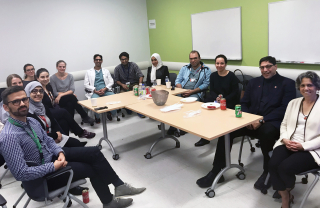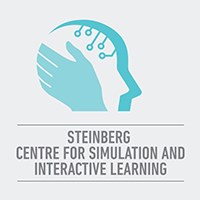“Dr. Nadkarni is an amazing and prolific research scientist, with more than 400 peer-reviewed manuscripts and 35 book chapters to his credit,” explained Dr. Farhan Bhanji, Pediatric Intensivist at the Montreal Children’s Hospital and Director of Education at the SCSIL, as he introduced Dr. Nadkarni during Pediatric Medical Grand Rounds. “But his real strength, in my view, is as a leader, innovator, implementer and educator.

We sat down for a heart-to-heart talk with this “giant of resuscitation” to find out what fuels his passion.
Q – When you graduated from medical school in 1984, you mentioned that the instructors would provide great theory and demonstrations, but that it was not very interactive and the trainees didn’t necessarily have an opportunity to practice. When did you realize that there was such a great need for enhanced CPR training and that simulation could optimize self-efficacy and operational performance of teams to deliver better process of care?
I think there are multiple “ah-ha” moments where that realization happened. There are two that I will speak of. The first was my very first night of internship—a very impressionable time. I was on call, taking care of a group of patients at the Children's National Medical Center in Washington, DC. One of the patients had a big mediastinal tumour, and there was a chance that the tumour would collapse on vena cava and obstruct the blood flow coming back to the heart. It happened that night, and the patient had a cardiac arrest in the intermediate care unit. I was the intern who climbed up on the stretcher to do CPR as we rode into the OR. We opened up the chest and lifted up the tumour—you could immediately see the blood streaming through the vena cava, and refilling the heart. The attending surgeon reached his hand in and squeezed the heart to get it going, and then, all of a sudden, it started beating. It was a miraculous event; I have never encountered anything so dramatic and vividly demonstrable of the delicate line between life and death again in my career.
As I think back on it, that excited me—the potential to take a completely dead, flaccid heart and all of a sudden bring it back to life. And that patient, that child, had a good outcome. It worked. Our efforts were successful. But the lack of preparedness struck me. I recognized that in our standard training, we encounter things that happen commonly. We can train for a few unusual things, but the concept of being able to train for a particular entity, right before it happens, would have been invaluable: how to climb on the stretcher, how to safely deliver CPR, how to open the chest. All of these things were very specialized to resuscitation and required contextualized training.
My second experience took place during my critical care fellowship. I encountered Dr. Arno L. Zaritsky, who had written the first Pediatric Advanced Life Support (PALS) textbook and was in the process of revising it to make it practical for training. Through him, I became involved with the national American Heart Association PALS resuscitation group. At that time, I had the opportunity to travel in the Philippines with Operation Smile, a volunteer, mission-oriented group that does cleft repair operations on kids. We went to an outpost hospital to train the staff in PALS, but they didn’t have any of the equipment or infrastructure that we traditionally used for the PALS course. I was very struck by the notion that we need really simple tools, and that the training has to be contextualized to the environment and the skill level of the trainees.
Those were several “ah-ha” moments during my early career development whose themes played out time and again. Yes, we need excellent courses and training, but we also need to have the personalized, just-in-time, contextualized environment. And that is where my career has taken me.
Q – You’ve talked about the importance of accepting switchbacks, but not defeat (setbacks) when pursuing your objectives in medicine. Can you elaborate on that?
I’m going to emphasize the difference in the concept of “switchbacks” versus “setbacks”…
When you’re climbing a mountain, say Mount Everest, you map out your route and many auxiliary routes. In fact, no team ever actually follows the trail they mapped out exactly as planned, because the factors change: the weather, the people, the time, the places, etc. Life is unpredictable. For mountain climbers, part of the plan is to hike up to a certain altitude, stay there for a day, then climb back down a ways to re-acclimate. When they encounter unexpected trail hazards or inclement weather, they execute a “switchback”, not considering it a “setback” (because they anticipated they were going to encounter the unexpected hazard).
But in medicine, when we encounter an unexpected obstacle and plans have to change, we often consider these setbacks. When we’re treating a patient, we sometimes follow a rigid clinical pathway. When something happens, and we can’t do it, when we can’t stick to the plan, we consider it a setback, and we get frustrated. The reality is that somewhere along the pathway, we know we’re going to encounter something that we want to do, but can’t. We have to stop, regroup, reorganize, replan, go around the obstacle—whatever is needed—with a new goal to get to where we want to be. That’s really just a switchback, not a setback.
"We need to stop thinking of things as setbacks in medicine, and start anticipating switchbacks."
Q – Have you ever climbed a mountain?
Every day… not physically, but our team has climbed many virtual mountains! You need good teamwork to climb a mountain, resilience, and a good guide. See, it’s very similar to medicine. You need an experienced team leader, but they can’t do it alone. Everybody has their role.
Q – You say that we are moving together in the right direction, but we need to simplify our tools. Why is that?
What’s very interesting to me is that even in developing countries, when you give a lecture, you almost always need a gimmick or new technology to get people interested and excited. People will come to an ECMO CPR lecture, but often what they need is really basic CPR. I can get them in the room by talking about a fancy new device, but what they really need to know is how to monitor the oxygen saturation in some way, shape or form… It could be done with a fancy device, or it could be just by looking at the colour of their lips. In most cases, resuscitation science takes us “back to the basics”!
Q – Are there any innovative technologies that you think have a lot of potential in this field?
There are a lot. The things that are really hot right now in resuscitation are more on the detection side of things: how can we recognize that a person has a heartbeat, pulse, etc. There are FDA-approved tools with sensors in the wristband that can essentially detect a pulse by wearing the device tightly against your skin. Similar to wearable “fitbits” and electrocardiograms, they know if you’re moving and can monitor your heart rhythm. And the data can be wirelessly transmitted to monitor you, and to geolocate you. That kind of early recognition sign, both in hospital and out of hospital, is technology that is not quite there yet, but very close.
I think it will be a gamechanger. If we could just recognize and know what the problem is when somebody has an emergency, that will trigger the appropriate response. For example, a sudden stopping of movement, a stopping of the heart, is likely to be ventricular fibrillation. That means we need a CPR defibrillator. Now if instead, there was a slowing down of the heartbeat, a dropping of the blood pressure, a dropping of the oxygen saturation over time, that is asphyxia, possibly the result of a narcotic overdose. What do we need? We need Narcan, rescue breathing, chest compressions; that’s what we need for that patient. This technology would allow us to identify the likely cause and the time and location of the problem. By combining this technology with apps like PulsePoint [which allows you to find Automated External Defibrillators and locate nearby citizens or off-duty professionals who are trained in CPR when a cardiac emergency occurs] you can mobilize the community and match the needs of the patient to the responder immediately. This will allow time for the ambulance to come. A little intervention in a timely manner can have huge impact on patient outcomes. This is where we’re heading, and where we’ll see some breakthroughs in the next couple of years.
 Q – During your time here, you and Dr. Deutsch shared career advice with the residents and fellows, and talked about the importance of building good relationships during your career. Is there anyone you’ve worked with who has motivated or inspired you?
Q – During your time here, you and Dr. Deutsch shared career advice with the residents and fellows, and talked about the importance of building good relationships during your career. Is there anyone you’ve worked with who has motivated or inspired you?
There really are quite a number. I think I’ve had many mentors. Dr. Arno L. Zaritsky was very influential in my early training because he was such a good scientist, such a thoughtful person. He taught me to make sure that whatever we did was evidence based. Because of his resuscitation interests, he had introduced me to several other future mentors. One is Dr. William H. Montgomery, who was one of the originators of the Advanced Cardiac Life Support (ACLS), Basic Life Support (BLS) and PALS courses. He was very supportive and inspiring, and encouraged me to take on big challenges. Another important mentor is a gentle pediatric cardiologist named Dr. Leon Chameides who really helped develop those first PALS courses. He had an artful way of wording things so that everyone could understand what he was talking about. He provided the contextualization piece, the importance of saying things in a way that others can hear them in order for someone to take action.
These mentors were very supportive and influential early on in my career, and encouraged me to think out of the box. One of my key mentors for life since then is my current boss, Dr. Robert Berg, a resuscitation scientist and pediatric intensive care doctor who is an inspiring force. He’s idealistic, and he has mentored and supported me throughout my career to encourage me to really think about studying the things that will make a difference, to focus on those things that will move us forward, and to begin with the end in mind.
Read more Highlights from our 14th Annual Flanders Family Visiting Professors in Medical Simulation.

